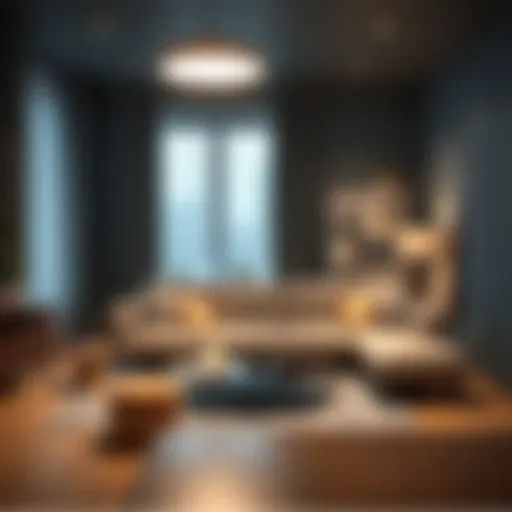Exploring the Best Faux Sheepskin: A Comprehensive Guide
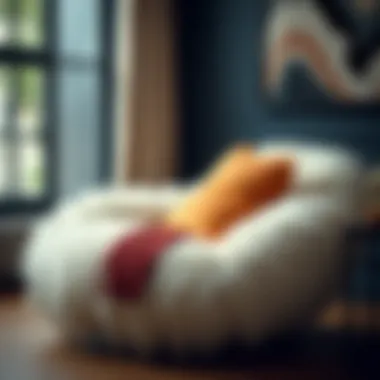

Intro
Faux sheepskin has become a significant player in the world of interior design, merging style with functionality. While traditional sheepskin has its merits, the rise of faux alternatives means that homeowners and designers now have options that tick the boxes for ethics, maintenance, and versatility. This guide aims to unpack everything about faux sheepskin, from what makes it a sound choice for your living space to current design trends that utilize this material effectively.
As we embark on this journey, we'll discuss various faux options available on the market, each designed for specific aesthetic goals and practical uses. But first, let’s dive into the surface of design trends that are rising in popularity and how faux sheepskin can fit seamlessly into these trends.
Design Trends
Current Trends in Furniture Styles
The furniture landscape is constantly evolving, with a noticeable shift towards eco-friendly materials and sustainable practices. Faux sheepskin perfectly aligns with this movement, offering similar aesthetic qualities without the environmental toll of real wool. Styles are gravitating toward mid-century modern and Scandinavian designs, where clean lines dominate but are softened by textures such as faux sheepskin. The versatility of faux sheepskin allows it to be a stylish addition to various types of furniture including:
- Accent chairs
- Throw blankets
- Rugs
With the rise of minimalism, the emphasis is also on creating spaces that feel both warm and inviting. Faux sheepskin brings a touch of coziness, bridging the gap between sleek and comfortable.
How to Incorporate Trends into Your Space
Incorporating faux sheepskin into your living space doesn't require a complete overhaul. Here are some practical tips to weave this fabric into your home decor:
- Layer It: Use faux sheepskin rugs over hardwood or tile floors to add warmth. Layer them in living areas to create visual interest.
- Mix Textures: Combine faux sheepskin with leather or metal finishes to add depth and create a balanced look.
- Go Beyond the Floor: Think about faux sheepskin pillows for sofas or chairs. They can introduce a touch of luxury without a hefty price tag.
"It's not just about following a trend; it's about creating a space that feels reflective of who you are, and faux sheepskin can aid in accomplishing this."
As trends continue to evolve, faux sheepskin remains a relevant fabric widely embraced for its adaptability. Next, let’s delve into the nitty-gritty of buying faux sheepskin products, ensuring you make decisions that are not just stylish, but smart.
Preamble to Faux Sheepskin
The discussion of faux sheepskin is vital in understanding modern textiles and their multifaceted applications. Faux sheepskin serves as an excellent alternative to traditional sheepskin, offering a blend of aesthetics, comfort, and ethical sourcing that resonates with today's conscious consumer. This section aims to unpack the unique aspects that make faux sheepskin a pivotal choice in home decor and beyond.
Faux sheepskin, by its very design, mimics the softness and warmth of natural sheepskin, while eliminating the ethical concerns associated with animal products. This means homeowners and designers can enjoy the plush texture of sheepskin without compromising on their values. It opens up a whole new dimension for styling different spaces, from cozy living rooms to modern bedroom setups.
As we venture deeper into this guide, you will see the objective of faux sheepskin is not just about aesthetics; it also engages with sustainability, affordability, and ease of care. Understanding these characteristics helps in making informed purchasing decisions, particularly in an era when consumers are increasingly discerning about what they bring into their homes. Whether you are a homeowner redecorating a space, a designer looking for innovative materials, or a DIY enthusiast daring to blend styles, navigating the realm of faux sheepskin can yield a wealth of possibilities.
"Faux sheepskin is more than just a textile; it’s a statement that embraces comfort while honoring ethics."
In this section, we will first get a clear understanding of what we mean by faux sheepskin. Following that, we will delve into its historical context to reveal how it has evolved into the beloved material it is today.
Characteristics of High-Quality Faux Sheepskin
When diving into the world of faux sheepskin, it’s imperative to understand what sets apart high-quality products from the run-of-the-mill options. These characteristics not only determine the aesthetic appeal but also play a crucial role in durability and overall satisfaction. A discerning homeowner or designer ought to look for certain key elements when selecting faux sheepskin, such as texture, durability, and color variations.
Texture and Feel
The texture of faux sheepskin is one of its most appealing features. Quality materials mimic the soft, plush feel of genuine sheepskin, providing a cozy and inviting atmosphere in any space. When you run your fingers across a high-quality piece, it should feel indulgently soft and lush, not coarse or synthetic. This tactile quality invites you to use it in various applications, from throw blankets to upholstery.
Moreover, the density of the fibers is important as well. A denser product often offers better insulation properties, making it suitable for colder environments. When choosing faux sheepskin, look for those products that boast an ultra-soft texture similar to the natural fibers but without the ethical concerns of animal products.
Durability and Longevity
Durability is another cornerstone of a quality faux sheepskin product. Unlike some cheaper alternatives that may break down quickly, high-quality faux sheepskin is engineered to withstand wear and tear. This means made from advanced synthetic fibers that resist matting and fraying. It should be resilient enough to be used in busy areas of your home or even high-traffic spaces like offices.
Investing in durable faux sheepskin not only enhances the longevity of your decor but also ensures you won’t be replacing items every few months. A well-crafted faux sheepskin can last for years if properly cared for, providing you with comfort and style over the long haul.
Color Variations and Patterns
Color should also be taken into account when evaluating faux sheepskin. High-quality products often feature a range of color options that are life-like and vibrant. From classic cream and taupe to bold shades like aqua or deep burgundy, the choices are endless. Moreover, look for options with patterns that further elevate the aesthetic appeal, such as geometric designs or seasonal florals.
This versatility allows homeowners and designers alike to integrate faux sheepskin into various styles, whether it be modern, rustic, or eclectic. The ability to mix and match colors and patterns adds a layer of creativity to your design choices. Don’t be afraid to experiment; the right faux sheepskin can be a showstopper in living rooms, bedrooms, or even commercial spaces.
"Quality faux sheepskin isn't just about looking good; it’s a combination of texture, durability, and colors that can transform a space."
Benefits of Choosing Faux Sheepskin
When it comes to selecting materials for interior design or personal fashion, faux sheepskin has carved out a niche that's hard to overlook. The range of benefits it offers is not only appealing for personal use, but it also plays a significant role in broader societal and ethical issues. This section shines a light on three key advantages, helping homeowners, designers, and DIY enthusiasts understand why faux sheepskin might be the right choice for their projects.
Animal Welfare Considerations
A vital factor in today’s material selection process is the impact on animal welfare. Faux sheepskin presents a compelling option by eschewing animal products altogether. In a world where sustainability and ethical considerations are gaining momentum, choosing faux materials means reducing demand for real sheepskin, which often relies on methods that raise serious ethical questions. By opting for faux, you are consciously aligning your choices with the values of compassion and responsibility.
"In a world full of choices, your decision can make a difference."
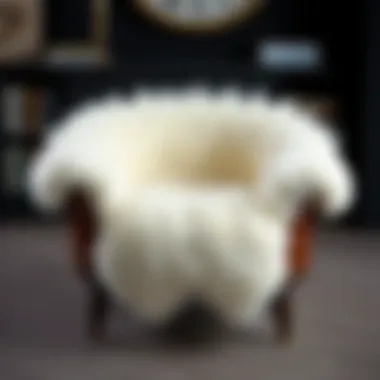

Moreover, many faux sheepskin products use fibers made from recycled sources, which not only addresses animal welfare concerns but also minimizes waste. This demonstrates that you can still achieve the plush, cozy feel that sheepskin offers while standing firm against animal cruelty practices.
Cost-Effectiveness Compared to Real Sheepskin
Now, let’s crunch some numbers. Faux sheepskin often comes in at a fraction of the cost of its real counterpart. For homeowners and designers on a budget, this is a breath of fresh air. Real sheepskin can set you back a pretty penny, while faux versions can mimic that luxurious look without leaving your wallet feeling light.
The financial benefits don’t stop at the initial price point. Faux sheepskin products usually come with lower maintenance costs. Real sheepskin requires specialized cleaning and care, which means more expenses down the line. Faux sheepskin, on the other hand, is generally machine washable and needs less upkeep. In a nutshell, choosing faux can lead to significant savings in both time and money, allowing you to allocate resources to other aspects of your project or decor.
Ease of Maintenance
One of the strongest selling points of faux sheepskin lies in its convenience. Unlike real sheepskin, which often requires meticulous cleaning and is sensitive to water and chemicals, faux variants are known for their durability and ease of care. Spills? No worries. A quick clean with a damp cloth usually does the trick, and many can even be tossed into the washing machine without a second thought.
Here are some quick maintenance tips for keeping your faux sheepskin looking fresh:
- Spot Clean: Use a mild detergent and warm water for minor stains.
- Routine Washing: Depending on the product, a gentle cycle in the washing machine keeps things clean.
- Air Dry: Avoid using the dryer; simply lay flat to dry to maintain shape and softness.
By choosing faux sheepskin, you're investing in practicality along with style, making it an ideal choice for families, pet owners, and even businesses looking for durability paired with comfort.
In summary, the benefits of faux sheepskin extend beyond mere aesthetics. From ethical sourcing to financial wisdom and maintenance simplicity, it becomes clear why many opt for this versatile material. As we continue to explore the many facets of faux sheepskin, it becomes increasingly evident that this choice serves not only personal preferences but also larger social values.
Applications of Faux Sheepskin in Design
Faux sheepskin is not just a material; it's a versatile ally that can transform spaces and elevate styles across various applications in design. Its practicality and aesthetic appeal have garnered attention from homeowners, designers, and retailers alike. In this section, we’ll explore how faux sheepskin enhances home decor, influences fashion and textiles, and contributes to pet products and accessories, thereby solidifying its role as a go-to material.
Home Decor and Furnishings
The use of faux sheepskin in home decor has become increasingly popular. Its soft texture and warmth provide an inviting touch to any room, making it ideal for throws, rugs, and upholstery. When draped over a chair or layered onto a sofa, it adds a cozy yet chic element to the space. Not only does it evoke a sense of comfort, but it also acts as a statement piece that can tie together various design elements.
- Texture Variance: The tactile quality of faux sheepskin is unmatched. Its fluffy cover can soften hard edges and bring a sense of balance to minimalist designs.
- Versatile Colorways: Available in numerous colors and patterns, faux sheepskin can seamlessly blend with existing decor themes—from modern to rustic.
- Layering Opportunities: Designers often layer faux sheepskin with other textiles to create visual depth. For example, pairing it with leather or cotton offers an engaging contrast that enriches the aesthetic of a room.
Faux sheepskin also presents a pragmatic advantage. It is easy to clean and maintain, which is crucial for high-traffic areas. Moreover, its affordability compared to real sheepskin makes it a budget-friendly option without compromising on style or comfort.
Fashion and Textiles
In the realm of fashion, faux sheepskin has carved out a niche of its own. Whether in garments or accessories, it serves both practical and stylistic purposes. The fabric's luxurious appearance makes it a popular choice among designers looking to produce stylish, eco-friendly clothing.
- Innovative Design: Designers often experiment with faux sheepskin in coats, jackets, and vests to create fashionable outerwear that keeps people warm without the ethical concerns associated with real fur.
- Texture in Fashion: The soft, plush nature of faux sheepskin can be used to create eye-catching details in apparel, such as collars, cuffs, or even as a lining for bags.
- Sustainable Choices: With growing awareness of sustainable fashion, faux sheepskin offers a responsible choice—allowing consumers to enjoy the aesthetics of animal textiles without contributing to animal cruelty.
The versatility of faux sheepskin in fashion extends to accessories, with items like handbags and footwear getting a stylish upgrade. Its adaptability allows designers to cater to a range of styles and preferences, ensuring that every fashionista can find something that resonates with their personal taste.
Pet Products and Accessories
Faux sheepskin has also made its way into the pet industry, offering comfort and style for our furry friends. Pet beds and blankets crafted from this material not only provide a cozy resting spot but also reflect the owner's sense of style.
- Comfort for Pets: Pets love to snuggle into soft, warm fabrics. Faux sheepskin pet beds can enhance their sleeping experience, making them feel snug and secure.
- Easy to Clean: Given that pets can be messy, the ease of cleaning faux sheepskin makes it a practical choice for pet owners. Many products are machine washable, ensuring hassle-free maintenance.
- Stylish Options: With a range of designs and colors available, pet owners can select items that fit their home decor aesthetics while providing their pets a comfortable space.
Faux sheepskin thus serves multiple purposes in the realm of pet products, combining practicality with design flair. It’s a win-win for those who want both functionality and aesthetics in pet accessories.
"Faux sheepskin doesn't just serve as a substitute; it redefines comfort and style across various applications—be it in the living room, closet, or pet corner."
Selecting the Best Faux Sheepskin Products
Choosing the right faux sheepskin products can truly transform your space, providing both aesthetic appeal and functionality. With a variety of choices available on the market, understanding the key factors that influence quality and performance is essential. Whether you’re sprucing up your home decor, looking to add a comfy layer to your fashion, or shopping for a cozy pet accessory, tackling this decision with a discerning eye ensures you’ll select an option that not only looks great but also stands the test of time. The right faux sheepskin is not just about appearance; it contributes to comfort, sustainability, and overall satisfaction.
Key Factors to Consider
Fabric Composition
Fabric composition refers to the materials that make up the faux sheepskin. Generally, high-quality faux sheepskin is crafted from polyester or acrylic fibers. These materials mimic the warmth and softness of natural wool but offer numerous advantages. High polyester content often yields a plush texture that feels indulgent against the skin.
The appeal of synthetic fibers lies in their durability. Faux sheepskin made from these materials resists wear and is less likely to mat over time. In terms of maintenance, fabrics like polyester are typically machine washable, a convenient trait that natural fibers often lack. However, it’s essential to look for options that are labeled as ultra-soft; not all polyester is created equal.
In essence, opting for high-grade polyester blends in faux sheepskin not only enhances the luxurious feel but also ensures longevity, making this choice practical and visually appealing.
Weight and Density
Weight and density play crucial roles in determining the quality and feel of faux sheepskin. Heavier options usually indicate a denser material which can enhance durability and provide a more luxurious look and feel. A heavier piece tends to hold its shape well, making it ideal for furniture or decorative applications.
Additionally, the density of the faux sheepskin contributes to its insulation properties. Thicker options can offer more warmth, ideal for winter decorating. When choosing weight, consider where you plan to use the product. Lightweight options may be suitable for throws or accents, while denser varieties are better for rugs or seat covers. An important aspect to remember is that while denser materials may be pricier, they often provide a better return on investment due to their longer lifespan.
Certification and Standards
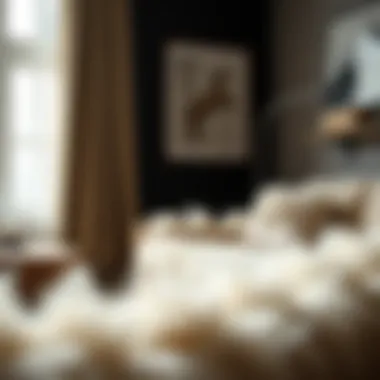

Certification and standards should not be overlooked when selecting faux sheepskin. Products that adhere to safety and environmental guidelines, such as Oeko-Tex Standard 100 or Global Recycling Standard, signal a commitment to quality and ethical production. These certifications indicate that the material has been tested for substances that could harm human health or the environment.
Moreover, standards can also provide assurance regarding the product's performance and durability. When you see a certification tag, it often means the item has passed specific tests for wear and tear, ensuring you receive a reliable product. So, prioritizing faux sheepskin that meets these standards means you're making a choice that aligns with health and ecological impacts.
Reputable Brands and Product Reviews
Utilizing reputable brands is integral when navigating the faux sheepskin market. Renowned manufacturers not only offer guarantees on product quality but also often produce more eco-friendly options. Reading product reviews can provide insights from other consumers who share their experiences regarding softness, durability, and usability. Sites such as Reddit and various home decor forums often contain valuable anecdotal evidence that can steer you towards high-quality products while avoiding potential disappointments. Look for recommendations that emphasize comfort, durability, and easy care to guide your selections.
Caring for Faux Sheepskin
Taking care of faux sheepskin is essential not just for longevity but also for aesthetics. Faux sheepskin can add a touch of luxury to various spaces. However, without proper care, it can lose its charm quickly. Maintaining these materials well ensures they remain soft, lustrous, and inviting, enhancing the overall appearance of your décor.
To get the most out of your faux sheepskin purchases, understanding specific care practices is key. This section delves into proper washing and drying methods, as well as storage tips to keep your faux sheepskin looking brand new.
Washing and Drying Methods
When it comes to washing faux sheepskin, gentleness is the name of the game. Here are some key points to consider:
- Read Labels: Always start by checking the care label on your faux sheepskin item, if it exists. Different brands might have varying recommendations.
- Hand Washing: If you're unsure, a gentle hand wash is often safer than tossing it into the machine. Use cold water mixed with a mild detergent. Soak the material briefly and avoid aggressive scrubbing to prevent damage.
- Machine Washing: For machine washing, choose a delicate or wool cycle. Use cold water and a mild soap to keep colors vibrant. It’s wise to place the item in a laundry bag to protect it from friction.
- Avoid Fabric Softeners: These can affect the texture adversely, making it less fluffy. Stick to the basics when washing.
- Drying: Air drying is recommended. Lay your faux sheepskin flat on a clean towel in a shaded area. Avoid direct sunlight or heat sources, as they can cause fading or shrinkage. If using a dryer, position it on a low heat setting and toss in some clean tennis balls to help retain its fluff.
"Proper care doesn’t just prolong the life of your faux sheepskin, it preserves the luxurious feel and appearance that you fell in love with at first sight."
Storage Tips
Storing faux sheepskin properly is just as crucial as washing. Here are some pointers to help maintain shape and integrity:
- Choose Breathable Storage: Avoid plastic bags, as they can trap moisture and lead to mildew. Instead, opt for a cotton or linen bag for breathable storage.
- Avoid Heavy Weights: When stacking faux sheepskin products, be careful about placing heavy items on top. This could flatten them out and ruin the plushness.
- Keep Away from Moisture: Humidity can wreak havoc on faux sheepskin, causing it to develop mildew. Store in a cool, dry space to mitigate this risk.
- Regular Airing Out: Give them an airing occasionally, especially if they haven't been used in a while. This helps keep any odors at bay and refreshes the fabric.
- Rotate Storage: If you have multiple pieces, switching them around can help avoid uneven wear and fading.
By adhering to these simple care tips, you ensure that your faux sheepskin remains a cherished piece in your home, providing all the warmth and comfort without the fuss.
Sustainability and Ethical Production
Sustainability is increasingly at the forefront of consumer decisions. This section highlights the significance of sustainability and ethical production in the faux sheepskin industry. As awareness about environmental impact grows, customers are becoming more discerning about the products they choose. Faux sheepskin isn't just about aesthetics; it resonates with a broader commitment to the environment.
Making sustainable choices when selecting faux sheepskin contributes to a reduction in resource depletion, while also promoting social responsibility within textile production. The benefits here are twofold: consumers can enjoy stylish, functional products without the guilt of animal cruelty, and they’re supporting brands that prioritize ecological well-being.
Eco-Friendly Materials in Faux Sheepskin
The foundation of any quality faux sheepskin lies in its materials. Not all faux sheepskin is created equal, and understanding what goes into its production is key. Many brands are now opting for recycled polyester and organic cotton blends over traditional synthetic fibers. These materials not only reduce waste but also lessen the carbon footprint associated with manufacturing.
It's essential to look for certifications or labels that indicate eco-friendly practices. For example, Oeko-Tex and Global Recycled Standard certifications serve as a badge of honor for brands that commit to environmental stewardship. Furthermore, some manufacturers are dabbling with bio-based materials, such as those derived from renewable resources, which present an exciting future for the industry.
- Benefits of using eco-friendly materials:
- Reduces reliance on finite resources
- Encourages innovation in material science
- Supports a healthier planet
Waste Management and Recycling Options
When faux sheepskin products reach the end of their life cycle, responsible disposal becomes crucial. Many consumers don’t realize that faux sheepskin can be recycled, depending on the materials used. After proper sorting and cleaning, products can often be repurposed into new textiles, carpeting, or insulation materials.
Educating the consumer not only empowers them but also creates a cycle of sustainability that benefits the environment. Here are a few simple steps for responsible disposal:
- Check for recycling programs in your area that accept textiles.
- Consider donation if the item is still usable, helping those in need while reducing waste.
- Look for take-back programs offered by some brands, which will recycle your products responsibly when they are no longer needed.
"Every small decision counts. By choosing sustainable faux sheepskin products and recycling them, consumers can play a part in promoting a healthier planet."
Comparing Faux Sheepskin to Other Materials
When choosing materials for interior design and textile applications, making informed comparisons proves essential. Faux sheepskin stands as a versatile alternative with unique traits and benefits. By contrasting faux sheepskin with other materials, one can appreciate its value in terms of aesthetics, practicality, and ethical considerations.
Faux Fur vs. Faux Sheepskin
Faux fur and faux sheepskin often occupy the same discussions in the realm of soft textiles. While both simulate animal fibers, each serves distinct purposes. Faux fur, designed to mimic the fluffy coats of various animals, typically finds its application in fashion and statement decor. Its vibrant colors and patterns can give a lively touch to garments and home accents.
Conversely, faux sheepskin leans toward more muted, natural hues, creating a comforting, cozy environment. Its plush texture excels in providing warmth, making it a favorite for throws, rugs, and upholstery. Homeowners might opt for faux sheepskin if they aim for a soft, inviting ambiance in living spaces. Moreover, the manufacturing processes for both materials can share similarities, yet faux sheepskin often prioritizes durability and ease of care, appealing to a broader audience.
Some distinguishing factors include:
- Appearance: Faux fur tends to have a more vibrant and varied palette, while faux sheepskin focuses on nuanced neutrals.
- Usage: Faux fur shines in clothing and playful designs, whereas faux sheepskin suits casual and comforting settings.
- Care: Faux sheepskin products are typically easier to maintain, especially in household items.
Natural Fibers vs. Synthetic Alternatives
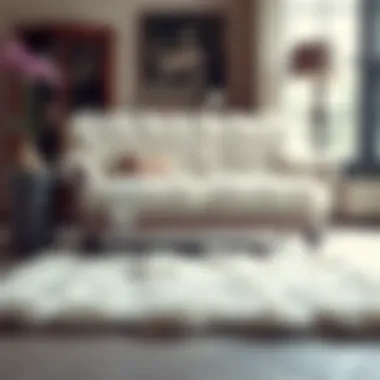

In recent years, the debate over natural vs. synthetic materials has gained momentum. Natural fibers, like wool or cotton, provide inherent breathability and a classic aesthetic. However, many homeowners face challenges with maintenance and cost when utilizing these materials. They may require specialized cleaning or might not withstand heavy use as well as synthetic versions.
Faux sheepskin, being a synthetic alternative, offers solutions to these limitations while also avoiding the ethical issues surrounding animal-derived materials. It delivers a similar look and feel to real sheepskin without the high maintenance costs or environmental impact of growing and harvesting animals.
Key considerations in this comparison include:
- Durability: Synthetic faux sheepskin often outlasts natural fibers, especially in high-traffic areas.
- Allergens: Faux options generally present fewer allergenic concerns compared to natural fibers, allowing a wider audience to enjoy their benefits.
- Sustainability: While natural fibers have their advantages, the production of faux materials can emphasize environmental responsibility, especially when made from recycled resources.
Ultimately, determining the best material hinges on individual needs, with faux sheepskin emerging as an appealing option blending comfort, style, and ethical awareness.
"Choosing the right material not only beautifies a space but also reflects personal values and lifestyle choices."
With a deeper understanding of these material comparisons, readers can navigate their choices more knowingly, enhancing their spaces while considering ethical and practical aspects.
Innovative Uses of Faux Sheepskin
Faux sheepskin isn't just for cozy blankets or fashionable jackets; it's quite a versatile material that finds its way into different facets of design and life. As we explore its innovative uses, it becomes clear that faux sheepskin can elevate both aesthetics and functionality in remarkable ways. From enhancing the home staging process to setting trends in interior design, its appeal lies in its ability to blend comfort, style, and practicality.
In Home Staging
Home staging plays a crucial role in selling properties, often transforming a mere space into an inviting haven for potential buyers. Faux sheepskin can be a game-changer in this arena. When used effectively, it weaves together warmth and luxury without crossing the budget line.
- Texture Highlighting: Faux sheepskin adds a layer of texture to space, creating a plush inviting atmosphere. It's common to place a faux sheepskin rug under a coffee table or beside a bed to soften hard surfaces, making rooms feel more homey.
- Color Coordination: One can find this material in a variety of colors and patterns, allowing home stagers to pair it with existing decor. This not only enhances the color palette of the space but also draws the eyes of potential buyers toward focal points in the home.
- Affordable Luxury: When compared to genuine sheepskin, faux options provide that luxury feel at a fraction of the price. This allows stagers to refresh the look of homes efficiently without incurring hefty costs.
By incorporating faux sheepskin into staging practices, agents can create environments that resonate with warmth and charm, making properties more appealing to buyers.
In Interior Design Trends
Faux sheepskin's place in interior design is not just a fleeting fad; its adoption into modern aesthetics signifies deeper trends in design thinking.
- Eclectic Mix: Designers are using faux sheepskin to blend different styles, marrying contemporary and rustic themes beautifully. It works seamlessly in various settings, from chic urban apartments to cozy suburban homes.
- Layering Techniques: This material is part of the layering trend as well. A chic faux sheepskin throw over a leather sofa, combined with soft cushions, can effortlessly create a multilevel visual interest while ensuring comfort and coziness.
- Sustainability Concerns: With a growing awareness of ethical consumption, faux sheepskin presents an eco-conscious alternative for designers who wish to maintain style while being mindful of animal welfare. Incorporating sustainable materials into design manifests not only stylish outcomes but also responsible choices.
"In the world of design, faux sheepskin is not just a substitute; it's a statement, indicating that luxury and sustainability can coexist harmoniously."
By understanding its diverse applications, homeowners and designers alike can make informed decisions that not only elevate aesthetics but also reflect values on sustainability.
Future Trends in Faux Sheepskin Materials
As we look ahead, the faux sheepskin industry is poised for exciting changes driven by technological advancements and evolving consumer preferences. Understanding these trends is critical for homeowners, designers, retailers, and enthusiasts alike, as they shape not only what products are available but also how they perform and fit into contemporary lifestyles.
Technological Advancements
Recent strides in technology have significantly impacted the production and quality of faux sheepskin materials. Innovations in fabric technology allow for enhanced durability and a more authentic feel, mimicking the softness and warmth of genuine sheepskin without the ethical concerns. Manufacturers are utilizing advanced weaves and textile treatments to create products that are not only aesthetically pleasing but also more resilient to wear and tear.
Moreover, advancements in dyeing techniques have led to a wider range of colors and patterns, appealing to diverse tastes and design preferences. For instance, environmentally conscious processes are emerging, ensuring less harmful chemicals are used, which benefits both the consumer and the planet. These technologies also contribute to a reduction in waste during production, making faux sheepskin a more sustainable option.
- Enhanced durability through innovative weaves
- Authentic feel thanks to advanced material treatments
- Wider color palette driven by improved dye processes
- Eco-friendly manufacturing methods
“As technology evolves, so does the ability to create not just faux sheepskin, but a whole new world of design opportunities that cater to ethical and aesthetic demands.”
Shifts in Consumer Preferences
Today's consumers are increasingly conscious of the choices they make, leading to a notable shift in how faux sheepskin products are perceived. There is a growing demand for sustainable and ethical options, prompting brands to highlight their commitment to animal welfare and environmental responsibility. This shift is not just about materials; it's about transparency. Shoppers want to know their products are responsibly sourced and environmentally friendly.
With the rise of social media platforms, consumers are also more connected than ever. Influencers and home décor enthusiasts are championing faux sheepskin for its versatility in design. This kind of visibility is affecting purchasing decisions, encouraging buyers to seek out stylish yet sustainable alternatives. As a result, shoppers are looking to integrate faux sheepskin into their spaces, favoring it for its aesthetic appeal and eco-conscious nature.
- Increased emphasis on ethical sourcing
- Social media influence shaping design trends
- Popularity of faux sheepskin in home décor
This evolution in consumer preferences caters to a wealth of opportunities for producers and retailers who align their offerings with these values. Through these trends, it is clear that faux sheepskin will not just remain a staple in interior design, but it will continuously adapt to reflect the desires of conscientious consumers.
Epilogue
Faux sheepskin has carved a unique niche in both interior design and everyday life. It’s not just a matter of aesthetics, but also about making responsible choices that align with one's values. This article has unpacked the many dimensions of faux sheepskin, ranging from its characteristics and benefits to its various applications and the latest trends shaping its future.
Recapitulating Key Insights
Throughout our exploration of faux sheepskin, several key insights emerge:
- Versatility: Faux sheepskin is incredibly adaptable. Whether it’s for a chic living room throw, stylish clothing, or even cozy pet beds, its applications span various sectors within home decor and fashion.
- Sustainability: With increasingly eco-friendly production methods and materials, faux sheepskin presents a sustainable alternative to tradional sheepskin, addressing animal welfare concerns while maintaining style and functionality.
- Affordability: Cost-effective solutions are vital for budget-conscious homeowners. Faux sheepskin offers the same luxurious look and feel as the real thing without the hefty price tag, making it accessible to a wider audience.
- Ease of Care: Its simple maintenance requirements, from easy washing to quick drying, make faux sheepskin an attractive option for busy individuals. This feature alone drives its popularity as a practical choice for modern lifestyles.
"Faux sheepskin isn’t merely a trend; it’s a thoughtful choice that embraces comfort, style, and ethical considerations."
The Importance of Informed Choices
Choosing faux sheepskin is more than a superficial decision. This guide emphasizes the need to become informed consumers. Understanding the characteristics that define quality faux sheepskin helps in selecting a product that will endure and elevate a space. Key factors like fabric composition, certifications, and durability should guide your purchasing decisions. Informed choices not only enable satisfaction in the short term but also contribute to long-term value and sustainability. By opting for respected brands and familiarizing oneself with product reviews, consumers can streamline their decisions and minimize the chance of disappointment.
Ultimately, as the trends evolve and the material itself continues to improve, being educated about faux sheepskin encourages a mindful approach to home decor and fashion. It’s about choosing not just for today but for a more sustainable tomorrow.









